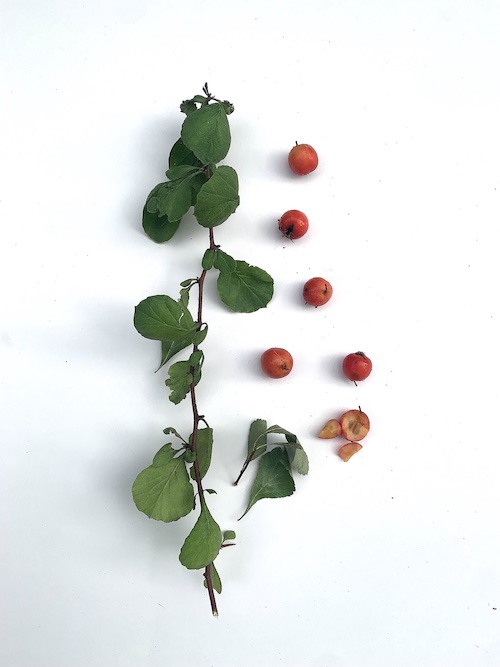
Hawthorn berries are edible, but not the seeds. Photo by Green Deane
There are many botanical mysteries, Hawthorns are one of the prime puzzlements among green plants. No one knows exactly how many species there are, dozens? Hundreds? Perhaps thousands. It’s a PhD waiting to happen. But we do know they are in the greater rose family, and the small fruit is applesque — so don’t eat the seeds. In hungrier times hawthorn jelly was popular particularly made from crataegus monogyna. It’s a no-cook jelly you can dry into a sweet snack. Although a European speciesI have seen crataegus monogyna growing near Boone, North Carolina, Hawthorn, now, is more known medicinally as a tea from the leaves and or fruit because they are an effective Beta Blocker for certain cardio vascular conditions.

Devil Walking stick fruit is not edible.
We also harvested a lot of chanterelles during our Gainesville Class, including some red chanterelles. They went well in an omelette. Also spied were the non-edible berries of the Devil’s Walking stick. Blossom and shoots are edible but not the fruit — which have a kind of Elderberry-on-a-bad-day flavor. It is irritating in foraging that some of the easiest things to identify are not edible.
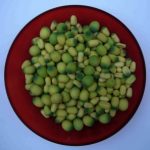
American lotus seeds ready for cooking. Photo by Green Deane
Seen twice this past week in Gainesville and Winter Garden were blossoming American Lotus. The first time I saw a small lake of these blossoms was when an old dry lakebed was deepened and reflooded for a housing development. The next spring suddenly what was for decades a dry lake was full of American Lotus blossoms. This is because the seeds can stay viable some 400 years, or so the experts report. Talk about a survival food! There are multiple edible parts on the American Lotus but I prefer the seeds. I also think when collecting by hand the seeds proved to be the most calories for the least amount of work. The roots are edible but digging them up can be a messy, laborious job. Locally American Lotus are easy to find now: Just look for a lake with large yellow blossoms on long stems. Further north and west they are a favorite sight on rivers such as the Mississippi. To read more about the American Lotus go here.
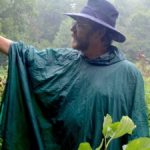
Classes are held rain or shine or cold. (Hurricanes are an exception.) Photo by Kelly Fagan.
Foraging Classes: Accompanying me in my foraging class this Saturday in Mead Garden is the publicity side of my book publisher, Keen Adventure. Sunday’s class will dodge thunderstorm in Largo.
August 12th, Mead Garden: 1500 S. Denning Dr., Winter Park, FL 32789. Meet at the bathrooms 9 a.m. This class will be attended by representatives of the company publishing my book. (See below)
August 13th, Eagle Lake, Largo fl. Meet at the dog park pavilion, 9 a.m.
For more information, to pre-pay or to sign up go here.
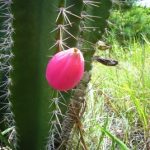
Cereus cactus fruit is wild Dragon Fruit. Photo by Green Deane
One of the joys this time of year is that cactus tunas are ripening: Cactus fruit are called Tuna. There are two or three general types of cactus locally, Opuntia and Nopales and a third with edible fruit, the Cereus, which is more an ornamental Dragon Fruit. How do you pick a Tuna (or cactus pad?) In a word carefully.
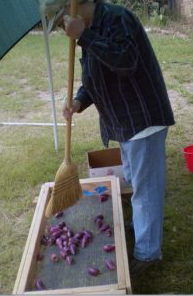
Sweeping glochids off is another option.
Most foragers know cactus have edible parts but what does one look for, generally? First make sure it’s a pad, segmented often oval or tear-drop shaped. You do not want anything that looks serpentine. Also no white sap. White sap in plants that resemble cactus can be very deadly even after being dry many years. In one case smoke from burning desiccated Euphorbia branches killed some stranded people. They were trying to stay warm around the fire on a cold desert night. So, pads, no white sap. While which cactus you collect (Opuntia, Nopales, or Cereus) might be the luck of the draw, the less spines the better, and the less glochids the much better. Glochids are tiny tuffs of sharp hair that hurt, are hard to dig out, and last for days. Ma Natures knows the pads and Tuna are good food so she protects them mightily. Big spines can be cut, burned or scraped off, glochids burned or washed off. Just scraping is not so successful with glochids. Wear stiff gloves without seams. Those little glochids will pass right through seams and get ya. Hint: Young pads, the ones we want anyway, often have not developed glochids. The Tuna have them so pick with tongs and sweep, wash or burn the painful spines off. Let us presume you have a spineless, glochidless young pad. What do you do with it? You can eat it raw, skin and all, or roast it or boil it. I know one restuarant that steams them (preserving color) then lightly grills them puting the pads whole on a Mexicanesque hamburgers. With older (de-spined) pads you can still eat them raw or cook. Usually the tougher spine “eyes” are removed just like you would with a potato. And the pad can be peeled as well. Pads at a certain point become woody and too tough to eat. The fruit, Tunas, are also edible after ridding them of glochids. They can have a raspberry flavor. The seeds are edible, too, but are extremely tough. You have to grind or roast them To read more about cactus click here.
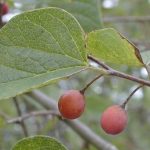
Hackberries, or sugarberries, are usually burnt orange in color.
There is a tree you should be scouting for now so when the fruit ripens next month you’ll have some already located. As in real estate so in foraging: Location, location, location. Hackberries (also widely know as Sugarberries) like to be near but not in fresh water. You can often find them about 10 feet above the local water table but I’ve seen them as low as three feet. Usually you can find them up the bank from the water. Older Hackberry bark will often be warty, sometimes heavily so. Leaves have uneven shoulders, and on the back side of the leaf notice three prominent veins at the base, unusual for tree leaves. The small-pea sized fruit is green now but will ripen this month or early September into a burnt orange. The entire fruit is edible though the seed is hard. To read more about them go here.
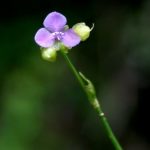
asdff
Doveweed, Murdannia, might be the smallest non-floating edible plant in the United States. Barely known, easily overlooked, yet very invasive. It pays to be small. For some young Doveweed is prime for soups, others view it as famine food. I can understand that. It’s closely related to a genus that gives me an upset stomach, the Commelinas (Dayflowers.) I use only Doveweed blossoms in my salad. To anyone used to finding Dayflowers the Doveweed will look familiar but only a few inches tall. It also has a lot of common names around the world including “Micky Mouse.” To read more about the Doveweed, go here.
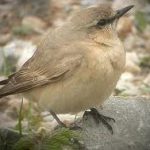
Isabelline wheateater
To my knowledge I’ve never met anyone named Isabell. So when the word “isabelline” cross my optical path about plants I had to look into it. “Isabell” means “God’s promise” presumably a positive one. It was very popular girl’s name in the 1880s, all but disappear until 2003 whereupon it had a resurgence in popularity until 2007. Now it is on the wane again. But what is isabelline? There are three application of which I have also apparently never heard of. One is what we could call Spanish Gothic Architecture. King and queen Ferdinand and Isabella got Columbus launched then turned to building cathedrals and the like. That style is called Isabelline, properly capitalized. I’m surprised they didn’t called it Ferdinine. The second use is a color: Isabelline. A color? Yes, and the word has been in use for at least 400 years so it is not a paint-store invention like “Baby Fawn” or “egg blue.”

A Himalayan Brown Bear (Ursus arctos isabellinus.)
Isabelline “means a light yellow-gray and used mostly to describe mushrooms, animals and birds. There is the Isabelline Wheateater, see above left, the Isabelline Shrike, and the Isabelline Bear, right. Horses that are a cross between a Golden Palomino and a Champagne Palomino are also called Isabelline. Now, what of the third use? Well… ahem….Isabelline is also a reference to faded underwear. The story comes from when Philip II of Spain laid siege to the berg of Ostend in 1601. His daughter, Isabella, Archduchess of Austria, made a rather presumptuous vow not to change her underwear until the city was taken, thinking dad would be home by supper, lunch by Sunday for sure… Unfortunately for Isabell — and those around her — the siege took three years. Thus the color of dingy underwear is “isabelline.”

You get the USB, not the key.
150-video USB would be a good end of spring present and is now $99. My nine-DVD set of 135 videos has been phased out. The USB videos are the same videos I have on You Tube. Some people like to have their own copy. The USB videos have to be copied to your computer to play. If you want to order the USB go to the DVD/USB order button on the top right of this page. That will take you to an order form. I’d like to thank all of you who ordered the DVD set over the years which required me to burn over 5,000 DVDs individually.

Green Deane Forum
Want to identify a plant? Perhaps you’re looking for a foraging reference? You might have a UFO, an Unidentified Flowering Object, you want identified. On the Green Deane Forum we — including Green Deane and others from around the world — chat about foraging all year. And it’s not just about warm-weather plants or just North American flora. Many nations share common weeds so there’s a lot to talk. There’s also more than weeds. The reference section has information for foraging around the world. There are also articles on food preservation, and forgotten skills from making bows to fermenting food.
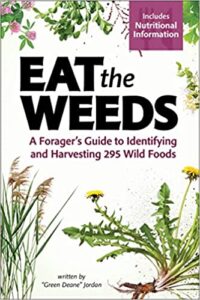 Now being printed is EatTheWeeds, the book. It should have 275 plants, 350-plus pages, index and color photos. Several hundred have been preordered on Amazon. Most of the entries include a nutritional profile. Officially it will be published Dec. 5th (to suit the publisher publicity demands) apparently to appeal to the winter market but can be delivered by mid-October
Now being printed is EatTheWeeds, the book. It should have 275 plants, 350-plus pages, index and color photos. Several hundred have been preordered on Amazon. Most of the entries include a nutritional profile. Officially it will be published Dec. 5th (to suit the publisher publicity demands) apparently to appeal to the winter market but can be delivered by mid-October
This is weekly newsletter #569. If you want to subscribe to this free newsletter you can find the sign-up form in the menu at the top of the page.
To donate to the Green Deane Newsletter click here.

